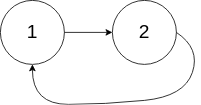LeetCode-in-Swift
141. Linked List Cycle
Easy
Given head, the head of a linked list, determine if the linked list has a cycle in it.
There is a cycle in a linked list if there is some node in the list that can be reached again by continuously following the next pointer. Internally, pos is used to denote the index of the node that tail’s next pointer is connected to. Note that pos is not passed as a parameter.
Return true if there is a cycle in the linked list. Otherwise, return false.
Example 1:

Input: head = [3,2,0,-4], pos = 1
Output: true
Explanation: There is a cycle in the linked list, where the tail connects to the 1st node (0-indexed).
Example 2:

Input: head = [1,2], pos = 0
Output: true
Explanation: There is a cycle in the linked list, where the tail connects to the 0th node.
Example 3:

Input: head = [1], pos = -1
Output: false
Explanation: There is no cycle in the linked list.
Constraints:
- The number of the nodes in the list is in the range
[0, 104]. -105 <= Node.val <= 105posis-1or a valid index in the linked-list.
Follow up: Can you solve it using O(1) (i.e. constant) memory?
To solve the “Linked List Cycle” problem, we can use the Floyd’s Tortoise and Hare algorithm. This algorithm uses two pointers moving at different speeds to detect if a cycle exists in the linked list. Here’s a step-by-step guide and the Swift implementation of the solution.
Steps to Solve the Problem
- Initialization:
- Define two pointers,
slowandfast, both starting at the head of the linked list.
- Define two pointers,
- Traversal and Cycle Detection:
- Move the
slowpointer one step at a time. - Move the
fastpointer two steps at a time. - If there is a cycle, the
fastpointer will eventually meet theslowpointer. - If the
fastpointer reaches the end of the list (i.e.,fastorfast.nextbecomesnil), there is no cycle in the linked list.
- Move the
- Return Result:
- If the
fastpointer meets theslowpointer, returntrueindicating a cycle. - If the
fastpointer reaches the end, returnfalse.
- If the
Swift Implementation
Here’s the implementation of the Solution class using the Floyd’s Tortoise and Hare algorithm:
// Definition for singly-linked list.
class ListNode {
var val: Int
var next: ListNode?
init(_ val: Int) {
self.val = val
self.next = nil
}
}
class Solution {
func hasCycle(_ head: ListNode?) -> Bool {
// Initialize slow and fast pointers
var slow = head
var fast = head
// Traverse the linked list
while fast != nil && fast?.next != nil {
slow = slow?.next // Move slow pointer one step
fast = fast?.next?.next // Move fast pointer two steps
// Check if slow and fast pointers meet
if slow === fast {
return true
}
}
// If we reach here, there is no cycle
return false
}
}
Explanation of the Swift Code
- Initialization:
- The
ListNodeclass defines the structure of a node in the linked list. - The
Solutionclass contains thehasCyclemethod which checks for a cycle.
- The
- Traversal and Cycle Detection:
- The
whileloop continues as long asfastandfast?.nextare notnil. - The
slowpointer is moved one step (slow = slow?.next). - The
fastpointer is moved two steps (fast = fast?.next?.next).
- The
- Cycle Detection:
- If the
slowpointer andfastpointer meet (if slow === fast), it indicates there is a cycle, and the method returnstrue. - If the loop exits because
fastorfast?.nextisnil, it means there is no cycle, and the method returnsfalse.
- If the
This approach ensures that we use constant space (O(1)) while efficiently detecting the presence of a cycle in the linked list.

